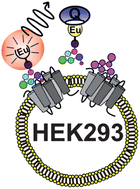A homogeneous single-label quenching resonance energy transfer assay for a δ-opioid receptor–ligand using intact cells†
Abstract
This study, a homogeneous assay system for delta opioid receptor binding

* Corresponding authors
a
Laboratory of Biophysics, Department of Cell Biology and Anatomy, Institute of Biomedicine, University of Turku, Tykistökatu 6 A 5th floor, FI-20520 Turku, Finland
E-mail:
khkopr@utu.fi
Tel: +358-2-333-7063
b Department of Anatomy and Cell Biology, Institute of Biomedicine, University of Oulu, Oulu FI-90014, Finland
This study, a homogeneous assay system for delta opioid receptor binding

 Please wait while we load your content...
Something went wrong. Try again?
Please wait while we load your content...
Something went wrong. Try again?
K. Kopra, Shweta, E. Martikkala, P. Hänninen, U. Petäjä-Repo and H. Härmä, Analyst, 2013, 138, 4907 DOI: 10.1039/C3AN00736G
To request permission to reproduce material from this article, please go to the Copyright Clearance Center request page.
If you are an author contributing to an RSC publication, you do not need to request permission provided correct acknowledgement is given.
If you are the author of this article, you do not need to request permission to reproduce figures and diagrams provided correct acknowledgement is given. If you want to reproduce the whole article in a third-party publication (excluding your thesis/dissertation for which permission is not required) please go to the Copyright Clearance Center request page.
Read more about how to correctly acknowledge RSC content.
 Fetching data from CrossRef.
Fetching data from CrossRef.
This may take some time to load.
Loading related content
